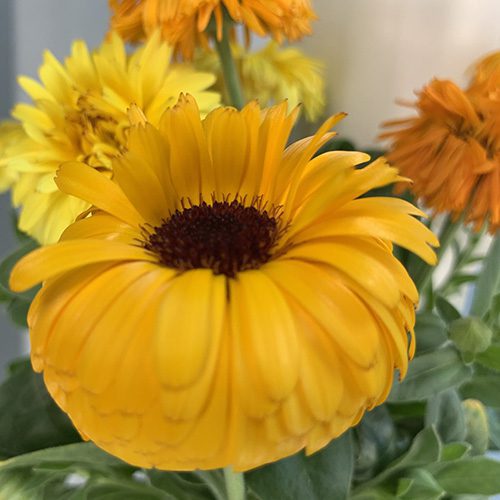Fiesta Gitana
Latin name: Calendula officinalis
🌱 Days to Sprout: 14-21
😋 Ready for Full Dose of plant food with true leaves or roots .5-inch long
✂️ Thin to: 3 plants per yCube
🍅 Days to Maturity: 50-60
💡 Light Zone: Medium
📏 Plant Size: 1 ft
💚 Care Level: Intermediate
Origin
Native to the Mediterranean, Fiesta Gitana flowers are widely used in the Middle East, Greece, and India for both aesthetic and medicinal purposes. Its name, meaning “giant party” in Spanish, refers to the semi-double blooms’ showy colors.
Qualities
Fiesta Gitana is a dwarf type of calendula flower, only growing up to 14 inches tall at most. The quick-blooming, semi-double flowers range in color from deep orange to bright yellow and pastel cream. Not only are the flowers beautiful, but also edible, with a tangy-bitter peppery flavor and anti-inflammatory, antiseptic, and antibacterial properties. The leaves have a bright, somewhat astringent scent.
Use
Sprinkle the edible flower petals over salads or add them to your favorite drinks to add a splash of color and a tangy, sweet taste. Fiesta Gitana also has many cosmetic and medicinal uses. You can make a natural dye and colorant from the petals, and, like Arnica or St. John's Wort, it’s a must-have in your natural first-aid kit!
Care & Harvest
✂️ Pruning: Check the roots monthly and trim any that are brown or extending past the yPod. To keep the plant bushy, neat, and within your Gardyn’s light, occasionally pinch off the tops of developing stalks. To encourage new flower bud development, remove dead flower heads, called deadheading. When deadheading, also trim back the bare stem that remains on the plant to prevent it from rotting.
🔎 Plant Health: Aphids and whiteflies are common pests, but you can use our prevention tricks to keep them at bay!
🌻 Harvest:To enjoy as cut flowers, harvest the blossoms when they are half-open by cutting the long stems and putting them in water immediately. To display your flowers’ beauty cut-free anywhere, use the Gardyn Vase! To use petals, cut the head of the flowers and spread the petals out to dry completely. Then use the dried petals to replace saffron or as a garnish. For medicinal use, the petals are best used before they begin to wither on the plant.
Our Plant Health & Nutrition Team thoroughly tests each variety we offer to bring you the most flavorful and high-quality plants. We regularly rotate our plant portfolio, so please note, availability varies.

